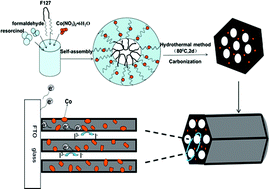Direct synthesis of cobalt nanoparticle-imbedded mesoporous carbons for high-performance dye-sensitized solar cell counter electrodes
Abstract
Metal Co nanoparticle-imbedded ordered mesoporous carbon (Co-OMC) materials were synthesized by a facile low-temperature hydrothermal approach of making phenolic resin-F127 composites with various amounts of cobalt nitrate and their subsequent carbonization. The synthesized Co-OMCs possess a high BET surface area, uniform 2-D hexagonal ordered mesostructure and large pore volume, and the imbedded Co nanoparticles are homogeneously distributed with sizes of 2–5 nm. In comparison with the pristine OMC, the Co-OMCs exhibit a higher graphitization degree, which is beneficial for enhancing the electrical conductivity. The Co-OMCs were applied as counter electrode catalysts in dye-sensitized solar cells (DSSCs), revealing that the electrocatalytic activity for I3− reduction is improved due to a synergistic catalytic effect between the OMC and an appropriate amount of Co nanoparticles, and the electrical conductivity was also enhanced. The DSSCs based on Co-OMC counter electrodes exhibit an optimum energy conversion efficiency of 7.02%, which is larger than that of the cell based on a pure OMC counter electrode (6.18%), and comparable to that of the cell with a Pt counter electrode (7.10%) under the same experimental conditions. The high energy conversion efficiency, low cost and simple fabrication process make the Co-OMC counter electrode promising as a potential replacement of the conventional Pt electrode in DSSCs.


 Please wait while we load your content...
Please wait while we load your content...